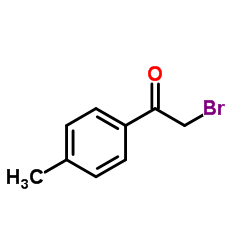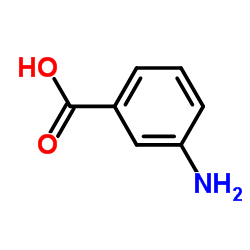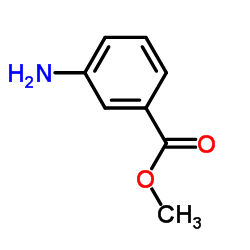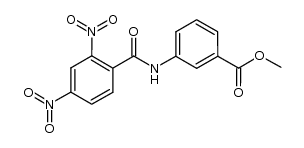FM19G11

FM19G11 structure
|
Common Name | FM19G11 | ||
|---|---|---|---|---|
| CAS Number | 329932-55-0 | Molecular Weight | 463.39600 | |
| Density | N/A | Boiling Point | N/A | |
| Molecular Formula | C23H17N3O8 | Melting Point | N/A | |
| MSDS | Chinese USA | Flash Point | N/A | |
Use of FM19G11FM19G11 is a hypoxia-inducible factor-1-alpha (HIF-1α) inhibitor, and it inhibits hypoxia-induced luciferase activity with an IC50 of 80 nM in HeLa cells. FM19G11 modulates other signaling pathways, including mTOR and PI3K/Akt/eNOS, when the HIF-1α pathway is inactivated under normoxic conditions[1][2]. |
| Name | [2-(4-methylphenyl)-2-oxoethyl] 3-[(2,4-dinitrobenzoyl)amino]benzoate |
|---|---|
| Synonym | More Synonyms |
| Description | FM19G11 is a hypoxia-inducible factor-1-alpha (HIF-1α) inhibitor, and it inhibits hypoxia-induced luciferase activity with an IC50 of 80 nM in HeLa cells. FM19G11 modulates other signaling pathways, including mTOR and PI3K/Akt/eNOS, when the HIF-1α pathway is inactivated under normoxic conditions[1][2]. |
|---|---|
| Related Catalog | |
| Target |
HIF-1α[1] |
| In Vitro | FM19G11 (30-300 nM) inhibits HIFα proteins in the HeLa cell lines[1]. FM19G11 (500 n m) promotes oligodendrocyte differentiation under hypoxia[1]. FM19G11 (300 nM; 3 days) suppresses the mRNA levels of O6-methylguanine DNA-methyltransferase (MGMT) significantly in hypoxic GBM‐XD, hypoxic T98G, and normoxic T98G cells[2]. M19G11 (300 nM; 3 days) significantly enhances the pro‐apoptotic effect of temozolomide (TMZ), although FM19G11 does not induce apoptosis by itself[2]. Cell Viability Assay[2] Cell Line: GBM‐XD and T98G cells Concentration: 300 nM Incubation Time: 3 days Result: Suppressed MGMT expression significantly in both cell lines in hypoxic culture. Downregulated MGMT expression substantially inT98G cells in normoxic culture. Cell Viability Assay[2] Cell Line: GBM‐XD and T98G cells Concentration: 300 nM Incubation Time: 3 days Result: Had no cytotoxicity by itself. Enhanced the cytotoxicity of TMZ in hypoxic GBM-XD cells, hypoxic T98G cells, and normoxic T98G cells. |
| In Vivo | FM19G11 ( intramedullary injection; 1-8 weeks) improve locomotion in severe spinal cord injury (SCI) [3]. FM19G11 ( intramedullary injection; 8 weeks) induces the expression of GAP43, an axon growth marker, and RIP, a marker for myelinated oligodendrocytes at the injury[3]. |
| References |
| Molecular Formula | C23H17N3O8 |
|---|---|
| Molecular Weight | 463.39600 |
| Exact Mass | 463.10200 |
| PSA | 167.60000 |
| LogP | 5.53380 |
| Appearance of Characters | powder,off-white to light brown |
| Storage condition | 2-8°C |
|
SECTION 1: Identification of the substance/mixture and of the company/undertaking Product identifiers Product name: FM19G11 REACH No.: A registration number is not available for this substance as the substance or its uses are exempted from registration, the annual tonnage does not require a registration or the registration is envisaged for a later registration deadline.
CAS-No.: 329932-55-0 Relevant identified uses of the substance or mixture and uses advised against Identified uses: Laboratory chemicals, Manufacture of substances SECTION 2: Hazards identification Classification of the substance or mixture Not a hazardous substance or mixture according to Regulation (EC) No. 1272/2008. This substance is not classified as dangerous according to Directive 67/548/EEC. Label elements Labelling according Regulation (EC) No 1272/2008 Pictogramnone Signal wordnone Hazard statement(s)none Precautionary statement(s) none Supplemental Hazardnone Statements The following percentage of the mixture consists of ingredient(s) with unknown acute toxicity: The following percentage of the mixture consists of ingredient(s) with unknown hazards to the aquatic environment: Other hazards - none SECTION 3: Composition/information on ingredients Substances Synonyms: 3-[(2,4-Dinitrobenzoyl)amino]-benzoic acid 2-(4-methylphenyl)-2-oxoethyl ester [2-oxo-2-(p-tolyl)ethyl] 3-[(2,4-dinitrobenzoyl)amino]benzoate Formula: C23H17N3O8 Molecular Weight: 463,4 g/mol CAS-No.: 329932-55-0 No components need to be disclosed according to the applicable regulations. SECTION 4: First aid measures Description of first aid measures General advice Consult a physician. Show this safety data sheet to the doctor in attendance. If inhaled If breathed in, move person into fresh air. If not breathing, give artificial respiration. Consult a physician. In case of skin contact Wash off with soap and plenty of water. Consult a physician. In case of eye contact Flush eyes with water as a precaution. If swallowed Never give anything by mouth to an unconscious person. Rinse mouth with water. Consult a physician. Most important symptoms and effects, both acute and delayed The most important known symptoms and effects are described in the labelling (see section 2.2) and/or in section 11 Indication of any immediate medical attention and special treatment needed no data available SECTION 5: Firefighting measures Extinguishing media Suitable extinguishing media Use water spray, alcohol-resistant foam, dry chemical or carbon dioxide. Special hazards arising from the substance or mixture Carbon oxides, nitrogen oxides (NOx) Advice for firefighters Wear self contained breathing apparatus for fire fighting if necessary. Further information no data available SECTION 6: Accidental release measures Personal precautions, protective equipment and emergency procedures Use personal protective equipment. Avoid dust formation. Avoid breathing vapours, mist or gas. Avoid breathing dust. For personal protection see section 8. Environmental precautions Do not let product enter drains. Methods and materials for containment and cleaning up Pick up and arrange disposal without creating dust. Sweep up and shovel. Keep in suitable, closed containers for disposal. Reference to other sections For disposal see section 13. SECTION 7: Handling and storage Precautions for safe handling Avoid formation of dust and aerosols. Provide appropriate exhaust ventilation at places where dust is formed. For precautions see section 2.2. Conditions for safe storage, including any incompatibilities Store in cool place. Keep container tightly closed in a dry and well-ventilated place. Recommended storage temperature: 2 - 8 °C Specific end use(s) A part from the uses mentioned in section 1.2 no other specific uses are stipulated SECTION 8: Exposure controls/personal protection Control parameters Components with workplace control parameters Exposure controls Appropriate engineering controls Handle in accordance with good industrial hygiene and safety practice. Wash hands before breaks and at the end of workday. Personal protective equipment Eye/face protection Use equipment for eye protection tested and approved under appropriate government standards such as NIOSH (US) or EN 166(EU). Skin protection Handle with gloves. Gloves must be inspected prior to use. Use proper glove removal technique (without touching glove's outer surface) to avoid skin contact with this product. Dispose of contaminated gloves after use in accordance with applicable laws and good laboratory practices. Wash and dry hands. The selected protective gloves have to satisfy the specifications of EU Directive 89/686/EEC and the standard EN 374 derived from it. Body Protection Choose body protection in relation to its type, to the concentration and amount of dangerous substances, and to the specific work-place., The type of protective equipment must be selected according to the concentration and amount of the dangerous substance at the specific workplace. Respiratory protection Respiratory protection is not required. Where protection from nuisance levels of dusts are desired, use type N95 (US) or type P1 (EN 143) dust masks. Use respirators and components tested and approved under appropriate government standards such as NIOSH (US) or CEN (EU). Control of environmental exposure Do not let product enter drains. SECTION 9: Physical and chemical properties Information on basic physical and chemical properties a) AppearanceForm: solid b) Odourno data available c) Odour Thresholdno data available d) pHno data available e) Melting point/freezing no data available point f) Initial boiling point and no data available boiling range g) Flash pointno data available h) Evapouration rateno data available i) Flammability (solid, gas) no data available j) Upper/lowerno data available flammability or explosive limits k) Vapour pressureno data available l) Vapour densityno data available m) Relative densityno data available n) Water solubilityno data available o) Partition coefficient: n- log Pow: 3,431 octanol/water p) Auto-ignitionno data available temperature q) Decompositionno data available temperature r) Viscosityno data available s) Explosive propertiesno data available t) Oxidizing propertiesno data available Other safety information no data available SECTION 10: Stability and reactivity Reactivity no data available Chemical stability Stable under recommended storage conditions. Possibility of hazardous reactions no data available Conditions to avoid no data available Incompatible materials Strong oxidizing agents Hazardous decomposition products Other decomposition products - no data available In the event of fire: see section 5 SECTION 11: Toxicological information Information on toxicological effects Acute toxicity no data available Skin corrosion/irritation no data available Serious eye damage/eye irritation no data available Respiratory or skin sensitisation no data available Germ cell mutagenicity no data available Carcinogenicity IARC:No component of this product present at levels greater than or equal to 0.1% is identified as probable, possible or confirmed human carcinogen by IARC. Reproductive toxicity no data available Specific target organ toxicity - single exposure no data available Specific target organ toxicity - repeated exposure no data available Aspiration hazard no data available Additional Information RTECS: Not available To the best of our knowledge, the chemical, physical, and toxicological properties have not been thoroughly investigated. SECTION 12: Ecological information Toxicity no data available Persistence and degradability no data available Bioaccumulative potential no data available Mobility in soil no data available Results of PBT and vPvB assessment PBT/vPvB assessment not available as chemical safety assessment not required/not conducted Other adverse effects no data available SECTION 13: Disposal considerations Waste treatment methods Product Offer surplus and non-recyclable solutions to a licensed disposal company. Dissolve or mix the material with a combustible solvent and burn in a chemical incinerator equipped with an afterburner and scrubber. Contaminated packaging Dispose of as unused product. SECTION 14: Transport information UN number ADR/RID: -IMDG: -IATA: - UN proper shipping name ADR/RID: Not dangerous goods IMDG: Not dangerous goods IATA:Not dangerous goods Transport hazard class(es) ADR/RID: -IMDG: -IATA: - Packaging group ADR/RID: -IMDG: -IATA: - Environmental hazards ADR/RID: noIMDG Marine pollutant: noIATA: no Special precautions for user no data available SECTION 15 - REGULATORY INFORMATION N/A SECTION 16 - ADDITIONAL INFORMATION N/A |
| RIDADR | NONH for all modes of transport |
|---|
|
~52% 
FM19G11 CAS#:329932-55-0 |
| Literature: Fundacion De La Comunidad Valenciana Centro De Investigacion Principe Felipe; Instituto de Salud Carlos III; Universidad de Valencia Patent: EP2292587 A1, 2011 ; Location in patent: Page/Page column 16 ; |
|
~% 
FM19G11 CAS#:329932-55-0 |
| Literature: Fundacion De La Comunidad Valenciana Centro De Investigacion Principe Felipe; Instituto de Salud Carlos III; Universidad de Valencia Patent: EP2292587 A1, 2011 ; |
|
~% 
FM19G11 CAS#:329932-55-0 |
| Literature: Fundacion De La Comunidad Valenciana Centro De Investigacion Principe Felipe; Instituto de Salud Carlos III; Universidad de Valencia Patent: EP2292587 A1, 2011 ; |
|
~% 
FM19G11 CAS#:329932-55-0 |
| Literature: Fundacion De La Comunidad Valenciana Centro De Investigacion Principe Felipe; Instituto de Salud Carlos III; Universidad de Valencia Patent: EP2292587 A1, 2011 ; |
|
A novel effect of DMOG on cell metabolism: direct inhibition of mitochondrial function precedes HIF target gene expression.
Biochim. Biophys. Acta 1847 , 1254-66, (2015) Abnormal accumulation of oncometabolite fumarate and succinate is associated with inhibition of mitochondrial function and carcinogenesis. By competing with α-ketoglutarate, oncometabolites also activ... |
|
|
Loss of SIRT3 Provides Growth Advantage for B Cell Malignancies.
J. Biol. Chem. 291 , 3268-79, (2016) B cell malignancies comprise a diverse group of cancers that proliferate in lymph nodes, bone marrow, and peripheral blood. SIRT3 (sirtuin 3) is the major deacetylase within the mitochondrial matrix t... |
|
|
Downregulation of duodenal SLC transporters and activation of proinflammatory signaling constitute the early response to high altitude in humans.
Am. J. Physiol. Gastrointest. Liver Physiol. 307(7) , G673-88, (2014) Solute carrier (SLC) transporters mediate the uptake of biologically active compounds in the intestine. Reduced oxygenation (hypoxia) is an important factor influencing intestinal homeostasis. The aim... |
| fm19g11 |




